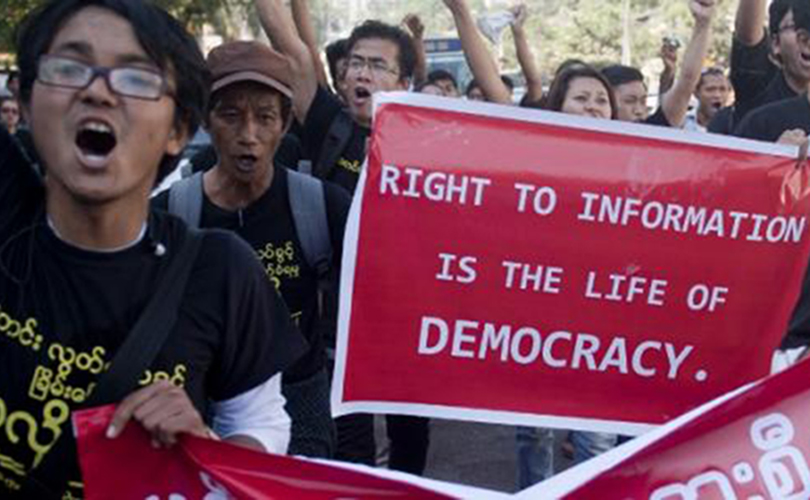
AUCKLAND (Pacific Scoop / Pacific Media Watch): Myanmar’s military government has only recently relaxed its tight control, with pro-democracy leader Aung San Suu Kyi poised to run for office in 2015. But media freedoms are a mixed bag with global aid needed, reports Asia-Pacific Journalism's Craig Hoyle.
New Zealand journalists are being urged to play a part in Myanmar’s press freedom as the Southeast Asian state approaches its first democratic elections in nearly 60 years.
The nation’s military government has only recently relaxed its tight control, with pro-democracy leader Aung San Suu Kyi poised to run for office in 2015.
Fairfax reporter Andrea Vance is among those taking a keen interest in Myanmar after first visiting several years ago.
“I was there in 2012 with the Prime Minister, and then I was there again last June with the Jefferson Fellowship, and then I went again for the East-West Centre Media Conference in March,” she says.
Her last two trips were courtesy of the Asia New Zealand Foundation, which is working to improve communication between journalists in the two countries.
“We’re seeing increased interest in Myanmar among New Zealand journalists since the 2011-2012 reforms,” says media adviser Rebecca Palmer.
“It’s good for New Zealand journalists to meet their counterparts in Asia and to have contacts in the region, particularly in the absence of New Zealand media outlets having foreign correspondents in Asia.”
Several issues
While in Myanmar this year, Vance noticed several issues faced by the local Burmese journalists.
“There was no journalism school, and these people were facing covering the first democratic elections in six decades, and it struck me they could do with some help,” she says.
“So I suggested we bring one of their journalists here before our elections, so they can see how our political coverage works.”
Vance’s suggestion led to a visit to New Zealand in August by Irrawaddy journalist Kyaw Hsu Mon.
Hsu Mon spent time in the parliamentary press gallery during her two weeks in New Zealand, and also visited the Pacific Media Centre. She contrasts press freedom here with the challenges she faces back in Myanmar.
“Military officials always want to stay away from us, and it’s very hard to get information,” she says. “It’s very difficult to access the government when we need to confirm information.
“When I am writing about some business story for example, I need to confirm with the Economic Ministry, but it’s very hard to get the figures and they don’t have the real information.”
Changes for better
However, Hsu Mon says things have definitely changed for the better for journalists in Myanmar over the past few years.
“Before 2011 the government did not allow us to publish daily newspapers, so there were only weekly journals, and every weekly journal had to submit a draft before they published, one week ahead, to the censorship board.
“The censorship board would make a lot of red pen, every week. So if we used a story that was restricted not to be published, we would be punished, for example suspended for one week.”
Danish student journalist Maria Danmark Nielsen recently completed an internship in Yangon with The Myanmar Times, and was surprised by how open the media now appeared.
“In the first couple of weeks I did a story about youth and politics, and asked young people about whether they wanted to be in politics, even when their parents had faced jail time, and I could do that story, so I was pretty surprised,” she says.
“I thought there would be some topics that we couldn’t write about, but there weren’t. It was pretty much the same process as a newspaper in Denmark.”
British Australian journalist Jessica Mudditt has been working in Myanmar since 2012 and says the media still face challenges despite the recent loosening of restrictions.
Honeymoon period
“There’s no longer a censorship board in place to screen our work and prevent it from seeing the light of day,” she says.
“However after the initial honeymoon period of 2011 and early 2012, it’s become quite clear that there are still certain limits regarding freedom of expression.
“Each journalist and editor must decide for themselves whether a certain article pushes the envelope too far, and the consequences for doing so are quite hard to determine in this new ear of ‘democratic change’.”
Mudditt says politics pervades almost every aspect of the Burmese media.
“I find that everyone I interview was profoundly affected by the constraints of the former military regime,” she says.
“For example, when I was commissioned by a trade magazine to write about Myanmar’s paint and varnish sector, I yawned inwardly, thinking it would be deadly boring.
“Yet what I found, among other things, is that for 26 years the only colours of paint available in Myanmar were produced by the nationalised paint industry – that is to say, the military - and were limited to five colours - white, grey, blue, yellow, and pink.
“Nothing else was on offer. Can you imagine that for almost 30 years?”
Worrying events
Despite the apparent new press freedom, there have been some worrying events recently for journalists in Myanmar.
Several journalists have been imprisoned over the past year, including five reporters from Unity Journal who were arrested after publishing a story on an alleged chemical weapons plant. They face charges of trespass and revealing state secrets.
In a World Press Freedom Day release, Human Rights Watch criticises what it says appear to be politically motivated prosecutions.
“International praise for expanding media freedoms in Burma has been undercut by arrests and intimidation of journalists,” says deputy Asia director Phil Robertson. “This serious backsliding raises concerns about the government’s commitment to a free press.”
Also of concern is a Media Law enacted in March, which gives the Ministry of Information sweeping powers to punish any media organisation for vague offences such as insulting religion or disturbing the rule of law.
Mudditt believes increased international contact is crucial to ensuring press freedom doesn’t slip back into the old pattern of censorship.
“If Myanmar professionals across every sector had the opportunity, no matter how brief, to experience and learn from organisations of international repute, I think it would deliver incalculable returns for the people of this country,” she says.
It’s a view echoed by Vance.
“I have many journalist friends in Myanmar that I speak to regularly, and it’s important to offer them support, and let them know the world is watching.
“It’s not just them campaigning for press freedom in Myanmar.”
Myanmar reporters protest new threats to press freedom
This work is licensed under a Creative Commons Attribution-NonCommercial 3.0 New Zealand Licence.




